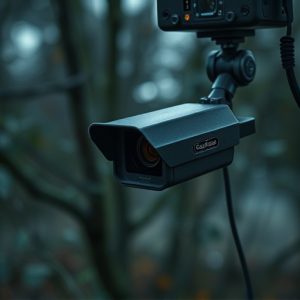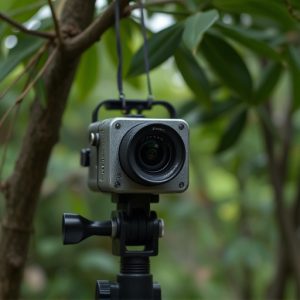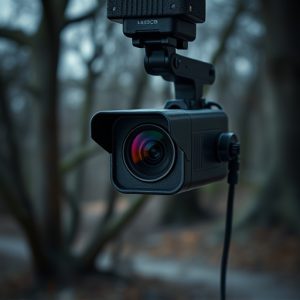Unveiling Tiny Camera Signals: Detection Tips & Legal Insights
Tiny cameras for home monitoring have transformed residential security with their discreet yet power…….
Tiny cameras for home monitoring have transformed residential security with their discreet yet powerful surveillance capabilities. These compact devices, powered by advanced image sensors and infrared LEDs, offer high-resolution video in low light conditions and around-the-clock monitoring. Effective deployment requires understanding signal detection techniques, such as frequency analysis and camera protocols. Strategically place cameras at hidden yet visible locations like entry points, windows, and common hiding spots for optimal coverage without raising suspicion. Advanced monitoring methods, including electromagnetic emission detection, further enhance security. However, legal and ethical considerations regarding hidden camera use must be addressed to ensure responsible and privacy-respecting deployment.
Uncover the secrets behind hidden monitoring devices with our comprehensive guide. In today’s digital age, tiny cameras for home monitoring have become a prevalent concern, offering both security and privacy challenges. This article explores effective tips to detect these covert signals, from understanding advanced camera technology to identifying discreet placement locations. We delve into cutting-edge techniques and emphasize legal considerations when navigating the ethical use of hidden cameras.
- Understanding Tiny Camera Technology for Home Monitoring
- Identifying Potential Locations for Discreet Signal Detection
- Advanced Techniques to Uncover Hidden Monitoring Device Signals
- Legal Considerations and Ethical Use of Hidden Cameras
Understanding Tiny Camera Technology for Home Monitoring
Tiny cameras for home monitoring have revolutionized home security, offering discrete yet powerful surveillance solutions. These compact devices are designed to blend seamlessly into everyday environments, providing homeowners with a sense of peace of mind. Understanding the technology behind these tiny cameras is crucial for effective deployment and signal detection.
Modern tiny cameras employ advanced image sensors, often smaller than a fingernail, capable of capturing high-resolution video in low light conditions. They are equipped with infrared (IR) LEDs that allow them to see in complete darkness, making them ideal for 24/7 monitoring. Signal detection involves identifying these cameras’ unique wireless signals, which can be hidden within the home’s network. By utilizing frequency analysis tools and understanding common camera protocols, users can uncover these signals, ensuring comprehensive coverage without compromising privacy.
Identifying Potential Locations for Discreet Signal Detection
When it comes to identifying potential locations for discreet signal detection, especially with tiny cameras for home monitoring, the key is to think like a thief or an intruder. Look for places where devices could be hidden but still maintain line-of-sight access to areas you want to monitor, such as entry points, windows, and common hiding spots. Devices like miniature CCTV cameras, designed for home security, can be cleverly placed in decorative items, plants, or even electrical outlets to remain virtually undetectable while providing 24/7 surveillance.
Consider the environment and lighting conditions at each potential location. Natural light can aid in image quality, so places with good illumination are ideal. Additionally, ensure that the camera’s field of view covers critical areas without capturing obvious details that could raise suspicion. Regularly review floor plans and consider using tools or apps that simulate camera angles to pinpoint the best discreet monitoring spots for your home security setup.
Advanced Techniques to Uncover Hidden Monitoring Device Signals
In the quest to uncover hidden monitoring device signals, advanced techniques have emerged as powerful tools. One of the most effective methods involves utilizing specialized equipment designed to detect electromagnetic emissions—even from the tiniest cameras used for home monitoring. These tiny cameras, often imperceptible to the naked eye, emit faint signals that can be traced using sensitive receivers and signal analyzers.
For enhanced detection, experts recommend employing frequency scanning tools capable of identifying unique signal patterns. By analyzing these patterns, investigators can pinpoint the location of hidden devices, whether they’re embedded in walls, hidden behind furniture, or disguised as everyday objects. Additionally, advanced software algorithms can process vast amounts of data, helping to distinguish between genuine signals and background noise, thus ensuring more accurate detection.
Legal Considerations and Ethical Use of Hidden Cameras
When employing tiny cameras for home monitoring, it’s crucial to navigate the legal and ethical landscape surrounding hidden camera use. The legality of such devices varies significantly by jurisdiction, with strict regulations in place to protect privacy rights. In many regions, capturing images or video without explicit consent is a violation of privacy laws. Even though these cameras are designed for covert deployment, ensuring they are installed and used responsibly is essential.
Ethically, the use of hidden monitoring devices raises concerns about trust, transparency, and individual freedom. It’s important to consider who has access to the footage, how it will be stored and protected from unauthorized access, and whether its use aligns with the values of fairness and respect for personal boundaries. Respecting privacy and using these tools responsibly are paramount to maintaining a harmonious balance between security and civil liberties.
In the age of advanced technology, tiny cameras for home monitoring offer a discreet and powerful way to enhance security. By understanding the capabilities of these miniature devices and employing techniques like signal detection and strategic placement, homeowners can stay vigilant. However, it’s crucial to navigate legal boundaries and use this technology ethically, ensuring privacy is respected while reaping the benefits of enhanced safety. Stay informed, be proactive, and protect your space with knowledge as your best ally.


